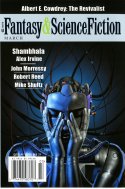
| Editor: | Gordon van Gelder |
| Issue: | Volume 110, No. 3 |
| ISSN: | 1095-8258 |
| Pages: | 162 |
This issue was slightly better than average. None of the stories blew me away, but none of them were awful either, and there were several enjoyable ones. Charles de Lint wrote an excellent review of Anansi Boys that highlighted part of Gaiman's tone that appeals to me as well. Robert K.J. Killheffer's book column was a good review of three fantasy novels. Kathi Maio did her usual good job at movie reviews, this time focusing on stop-motion animation.
"Shambhala" by Alex Irvine: In a typical SF future twist, human upload has been perfected and many people have left flesh and blood life to live in a virtual paradise in the computers. In an atypical twist, the human world has suffered because of it, leaving a battered economy and fewer people to maintain the systems in which these uploaded personalities run. This is the story of what happens when the system starts to crash.
The idea is an intriguing one. The execution did little for me. The cynical looks inside the corporation responsible for running the virtual reality were good, but the scenes inside the virtual reality itself aimed for a surreal breakdown and managed incoherence. Combine that with a distinctly unsatisfying ending and a mediocre reveal of the only secret the virtual reality seemed to have to offer, and I was unimpressed. (5)
"The True History of the Picky Princess" by John Morressy: Like many of Morressy's short stories, this is an ironic take on a fairy-tale world. This time, a princess is blessed by three fairies with gifts of beauty, self-esteem, and very picky taste. When it comes time to be married, the last of course causes trouble — ridiculous tests are put before princes who come as suitors, and her parents despair of ever seeing her married. The problem is finally resolved by a far more practical fairy. Lightly amusing. (6)
"The Revivalist" by Albert E. Cowdrey: This is my favorite of the Cowdrey short stories I've read, perhaps because he moves out of his typical atmospheric New Orleans setting and tells a story more focused on character than on surroundings. The first-person protagonist, from early in his life, is a remarkably sound sleeper, and in time he realizes that when he sleeps, he hibernates, even slowing his aging process. He decides to prolong his life as long as he can and works on hibernating for longer and longer, living through the 1920s and 1930s, sleeping through World War II, seeing reversals of fortune from changes in the economy and Prohibition, and coping with a strange and deteriorating relationship with his wife. The narrative voice is likeable and amusing and the story kept me interested all the way through. (7)
"From the Mouths of Babes" by Trent Hergenrader: This is the story of a remarkably precocious child, on the run with his father, having escaped from a not-clearly-defined scientific experiment. The story plays with the balance of power between the adult and the child, and then twists into a sharply emotional ending that doesn't follow the traditional pattern for this story. Quite effective. (7)
"The Capacity to Appear Mindless" by Mike Shultz: Integration of goblin and human schools is a difficult challenge. The humans are so strange and fragile, not particularly bright, and smell horrible. Still, Boarsnout Spinesnapper is trying the best in his classroom, and it's really not his fault when one of the humans gets terrorized over nothing. He has to find a way to show the school administration that all the students are equal and getting along in his class after that or he's dead meat. A cute idea well-executed, with lots of fun bits of alienation as goblin practices are taken for normal and human practices seem bizarrely weird. (7)
"Czesko" by Ef Deal: A local criminal and hard case has to get baptized in order to be able to leave a bar and not be trapped as a half-dead zombie. The story is written in a very strong first-person style, simulating verbal story-telling, and I found it a bit off-putting and not that interesting. I didn't really care about the characters or their terrorizing of a few priests and ministers. Still, the punch line was worth a laugh. (5)
"Intolerance" by Robert Reed: Another story of a precocious (apparently) child, this child quickly reveals himself to be something more adult and more sinister. At the start, this felt a bit like fantasy; it then becomes SF, with a truly dark look at the possibilities of control over aging. By the conclusion, the deeply unpleasant protagonist and the punishments he faces in the world have turned the story into something closer to psychological horror. Reed's stories have sharp barbs and this is no exception. I found it a bit too unpleasant and twisted to be fully enjoyable. (6)
Reviewed: 2006-08-13